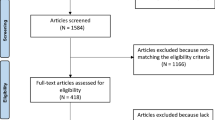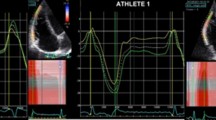Abstract
Objectives
The traditional view of differential left ventricular adaptation to training type has been questioned. Right ventricular (RV) data in athletes are emerging but whether training type mediates this is not clear. The primary aim of this study was to evaluate the RV phenotype in endurance- vs. resistance-trained male athletes. Secondary aims included comparison of RV function in all groups using myocardial speckle tracking, and the impact of allometric scaling on RV data interpretation.
Methods
A prospective cross-sectional design assessed RV structure and function in 19 endurance-trained (ET), 21 resistance-trained (RT) and 21 sedentary control subjects (CT). Standard 2D tissue Doppler imaging and speckle tracking echocardiography assessed RV structure and function. Indexing of RV structural parameters to body surface area (BSA) was undertaken using allometric scaling.
Results
A higher absolute RV diastolic area was observed in ET (mean ± SD: 27 ± 4 cm2) compared to CT (22 ± 4 cm2; P < 0.05) that was maintained after scaling. Whilst absolute RV longitudinal dimension was greater in ET (88 ± 9 mm) than CT (81 ± 10 mm; P < 0.05), this difference was removed after scaling. Wall thickness was not different between ET and RT and there were no between group differences in global or regional RV function.
Conclusion
We present some evidence of RV adaptation to chronic ET in male athletes but limited structural characteristics of an athletic heart were observed in RT. Global and regional RV functions were comparable between groups. Allometric scaling altered data interpretation in some variables.



Similar content being viewed by others
Abbreviations
- ARVC:
-
Arrhythmogenic right ventricular cardiomyopathy
- ASE:
-
American Society of Echocardiography
- BSA:
-
Body surface area
- CT:
-
Control subjects
- ε :
-
Strain
- ET:
-
Endurance-trained athlete
- FAC:
-
Fractional area change
- LV:
-
Left ventricular
- PASP:
-
Pulmonary artery systolic pressure
- PLAX:
-
Parasternal long axis
- PSAX:
-
Parasternal short axis
- RT:
-
Resistance-trained athlete
- RV:
-
Right ventricle
- RVD area:
-
Right ventricular end-diastolic area
- RVD1:
-
Right ventricular basal inflow
- RVL:
-
Right ventricular length
- RVOT:
-
Right ventricular outflow tract
- SR:
-
Strain rate
- SRA’:
-
Strain rate during late ventricular diastole
- SRE’:
-
Strain rate during early ventricular diastole
- SRS’:
-
Strain rate during ventricular systole
- STE:
-
Speckle tracking echocardiography
- TAPSE:
-
Tricuspid annular plane systolic excursion
- TDI:
-
Tissue Doppler imaging
References
Arbab-Zadeh A, Perhomen M, Howden E, Peshock R, Zhang R, Adams-Huet B, Haykowsky M, Levine B (2014) Cardiac remodelling in response to 1 year of intensive endurance training. Circ J 130:2152–2161
Baggish AL, Wang F, Weiner RB, Elinoff JM, Tournoux F, Boland A, Picard MH, Baggish AL, Wang F, Weiner RB, Elinoff JM, Tournoux F, Boland A, Picard MH, Hutter AMJR, Wood MJ (2008) Training-specific changes in cardiac structure and function: a prospective and longitudinal assessment of competitive athletes. J Appl Physiol 104:1121–1128
Batterham A, George K, Whyte G, Sharma S, McKenna W (1999) Scaling cardiac structural data by body dimensions: a review of theory, practice, and problems. Int J Sports Med 20:495–502
Batterham A, Shave R, Oxborough D, Whyte G, George K (2008) Longitudinal plane colour tissue-Doppler myocardial velocities and their association with left ventricular length, volume, and mass in humans. Eur J Echocardiogr 9(4):542–546 (Epub 2008 Mar 11)
D’Andrea A, Riegler L, Golia E, Cocchia R, Scarafile R, Salerno G, Pezzullo E, Nunziata L, Citro R, Cuomo S (2013) Range of right heart measurements in top-level athletes: the training impact. Int J Cardiol 164:48–57
Dewey F, Rosenthal D, Murphy DJ, Froelicher V, Ashley E (2008) Does size matter? Clinical applications of scaling cardiac size and function for body size. Circulation 117:2279–2287
George KP, Wolfe LA, Burggraf GW (1991) The ‘athletic heart syndrome’. A critical review. Sports Med 11:300–330
George KP, Batterham AM, Jones B (1998) Echocardiographic evidence of concentric left ventricular enlargement in female weight lifters. Eur J Appl Physiol Occup Physiol 79:88–92
George K, Sharma S, Batterham A, Whyte G, McKenna W (2001) Allometric analysis of the association between cardiac dimensions and body size variables in 464 junior athletes. Clin Sci (Lond) 100:47–54
Grossman W, Jones D, McLaurin L (1975) Wall stress and patterns of hypertrophy in the human left ventricle. J Clin Investig 56:56
Haykowsky Teo KK, Quinney AH, Humen DP, Taylor DA (2000) Effects of long term resistance training on left ventricular morphology. Can J Cardiol 16:35–38
Haykowsky M, Taylor D, Teo K, Quinney A, Humen D (2001) Left ventricular wall stress during leg-press exercise performed with a brief valsalva maneuver. Chest 119:150–154
King G, Almuntaser I, Murphy RT, la Gerche A, Mahoney N, Bennet K, Clarke J, Brown A (2013) Reduced right ventricular myocardial strain in the elite athlete may not be a consequence of myocardial damage. “Cream Masquerades as Skimmed Milk”. Echocardiography 30:929–935
Koc M, Bozkurt A, Akpinar O, Ergen N, Acarturk E (2007) Right and left ventricular adaptation to training determined by conventional echocardiography and tissue Doppler imaging in young endurance athletes. Acta Cardiol 62:13–18
la Gerche A, Burns AT, D’hooge J, Macisaac AI, Heidbüchel H, Prior DL (2012) Exercise strain rate imaging demonstrates normal right ventricular contractile reserve and clarifies ambiguous resting measures in endurance athletes. J Am Soc Echocardiogr 25(253–262):e1
La Gerche A, Heidbuchel H, Burns AT, Mooney DJ, Taylor AJ, Pfluger HB, Inder WJ, Macisaac AI, Prior DL (2011) Disproportionate exercise load and remodeling of the athlete’s right ventricle. Med Sci Sports Exerc 43:974–981
Lang RM, Bierig M, Devereux RB, Flachskamp FA, Foster E, Pellikka PA, Picard MH, Roman MJ, Seward J, Shanewise JS, Solomon SD, Spencer KT, Sutton MS, Stewart WJ (2005) Recommendations for chamber quantification: a report from the American Society of Echocardiography’s Guidelines and Standards Committee and the Chamber Quantification Writing Group, developed in conjunction with the European Association of Echocardiography, a branch of the European Society of Cardiology; Chamber Quantification Writing Group; American Society of Echocardiography’s Guidelines and Standards Committee; European Association of Echocardiography. J Am Soc Echocardiogr 18:1440–1463
Lang RM, Badano LP, Mor-Avi V, Afilalo J, Armstrong A, Ernande L et al (2015) Recommendations for cardiac chamber quantification by echocardiography in adults: an update from the American Society of Echocardiography and the European Association of Cardiovascular Imaging. J Am Soc Echocardiogr 28(1):1–39
Luijkx T, Cramer M, Buckens C, Zaidi A, Rienks R, Mosterd A, Prakken N, Dijkman B, Mali W, Velthuis B (2013) Unravelling the grey zone: cardiac MRI volume to wall mass ratio to differentiate hypertrophic cardiomyopathy and the athlete’s heart. Brit J Sports Med. doi:10.1136/bjsports-2013-092360
MacDougall JD, Tuxen D, Sale DG, Moroz JR, Sutton JR (1985) Arterial blood pressure response to heavy exercise. J Appl Physiol 58:785–790
Marcus FI, McKenna WJ, Sherrill D, Basso C, Bauce B, Bluemke DA, Calkins H, Corrado D, Cox MG, Daubert JP (2010) Diagnosis of arrhythmogenic right ventricular cardiomyopathy/dysplasia Proposed Modification of the Task Force Criteria. Eur Heart J 31:806–814
Maron BJ, Thompson PD, Ackerman MJ, Balady G, Berger S, Cohen D, Dimeff R, Douglas PS, Glover DW, Hutter AM (2007) Recommendations and considerations related to preparticipation screening for cardiovascular abnormalities in competitive athletes: 2007 update a scientific statement from the American Heart Association Council on Nutrition, Physical Activity, and Metabolism: endorsed by the American College of Cardiology Foundation. Circulation 115:1643–1655
Morganroth J, Maron BJ, Henry WL, Epstein SE (1975) Comparative left ventricular dimensions in trained athletes. Ann Intern Med 82:521–524
Oxborough D, George K, Birch K (2012a) Intraobserver reliability of two-dimensional ultrasound derived strain imaging in the assessment of the left ventricle, right ventricle, and left atrium of healthy human hearts. Echocardiography 29:793–802
Oxborough D, Sharma S, Shave R, Whyte G, Birch K, Artis N, Batterham A, George K (2012b) The right ventricle of the endurance athlete: the relationship between morphology and deformation. J Am Soc Echocardiogr 25:263–271
Pagourelias ED, Kouidi E, Efthimiadis GK, Deligiannis A, Geleris P, Vassilikos V (2013) Right atrial and ventricular adaptations to training in male caucasian athletes: an echocardiographic study. J Am Soc Echocardiogr 26:1344–1352
Pela G, Bruschi G, Montagna L, Manara M, Manca C (2004) Left and right ventricular adaptation assessed by Doppler tissue echocardiography in athletes. J Am Soc Echocardiogr 17:205–211
Prakken NH, Velthuis BK, Teske AJ, Mosterd A, Mali WP, Cramer MJ (2010) Cardiac MRI reference values for athletes and nonathletes corrected for body surface area, training hours/week and sex. Eur J Cardiovasc Prev Rehabil 17:198–203
Rudski LG, Lai WW, Afilalo J, Hua L, Handschumacher MD, Chandrasekaran K, Solomon SD, Louie EK, Schiller NB (2010) Guidelines for the echocardiographic assessment of the right heart in adults: a report from the American Society of Echocardiography endorsed by the European Association of Echocardiography, a registered branch of the European Society of Cardiology, and the Canadian Society of Echocardiography. J Am Soc Echocardiogr 23:685–713 (quiz 786–788)
Teske A, Cox M, de Boec B, Doevendans P, Hauer R, Cramer M (2009a) Echocardiographic tissue deformation imaging quantifies abnormal regional right ventricular function in arrhythmogenic right ventricular dysplasia/cardiomyopathy. J Am Soc Echocardiogr 22:920–927
Teske A, Prakken N, de Boeck B, Velthuis B, Doevendans P, Cramer M (2009b) Effect of long term and intensive endurance training in athletes on the age related decline in left and right ventricular diastolic function as assessed by Doppler echocardiography. Am J Cardiol 104:1145–1151
Utomi V, Oxborough D, Whyte GP, Somauroo J, Sharma S, Shave R, Atkinson G, George K (2013) Systematic review and meta-analysis of training mode, imaging modality and body size influences on the morphology and function of the male athlete’s heart. Heart 99:1727–1733. doi:10.1136/heartjnl-2012-303465
Utomi V, Oxborough D, Ashley E, Lord R, Fletcher S, Stembridge M, Shave R, Hoffman M, Whyte G, Somauroo J, Sharma S, George K (2014) Predominance of normal left ventricular geometry in the male ‘athlete’s heart’. Heart. doi:10.1136/heartjnl-2014-305904
von Elm E, Altman D, Egger M, Pocock S, Gøtzsche P, Vandenbroucke J (2008) The Strengthening the Reporting of Observational Studies in Epidemiology (STROBE) statement: guidelines for reporting of observational studies. Internist (Berl) 49:688–693
Acknowledgments
Study participants, coaches, British Aikido Association National Squad/team members, UK; Western States Endurance Run Foundation, USA and Dr Nick Sculthorpe for providing technical support.
Conflict of interest
None.
Author information
Authors and Affiliations
Corresponding author
Additional information
Communicated by David C. Poole.
Rights and permissions
About this article
Cite this article
Utomi, V., Oxborough, D., Ashley, E. et al. The impact of chronic endurance and resistance training upon the right ventricular phenotype in male athletes. Eur J Appl Physiol 115, 1673–1682 (2015). https://doi.org/10.1007/s00421-015-3147-3
Received:
Accepted:
Published:
Issue Date:
DOI: https://doi.org/10.1007/s00421-015-3147-3




